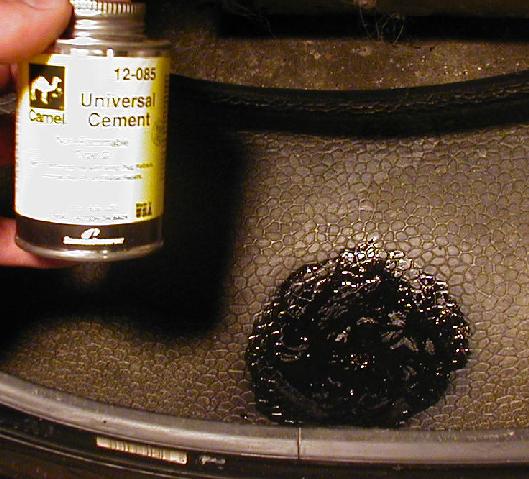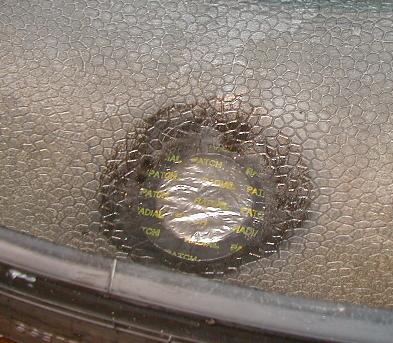
Remove the tire. Clean out any steel wires around the hole that could puncture the new patch. If you aren't using a plug-patch, you may want to fill the hole with a Barge cement first. This particular tire was plugged to get home, so the plug was just trimmed flush and left in place. According to Dunlop, you should never repair a hole more than 1/4-inch in diameter.
Clean around the patch with lacquer thinner, then use a stone in a die grinder to rough up the area and remove the ribs from the tire (tire guys call this step "buffing"). Clean with lacquer thinner again (tire guys call this step "liquid buffing").

Work in a good coat of universal cement and let it air dry completely. Be patient, it may take fifteen minutes. I don't what exactly this universal cement is. I've tried rubber cement and it didn't bond to the patch very well. I've tried Barge cement, and while it bonded to the tire well enough to patch the hole by itself, it didn't seem to stick to the patch well either. This unversal cement (a tire-specific contact cement) sticks to the tire and bonds to the patch (and to Barge cement) extremely well.

Remove the protective backing from the radial patch and press it over the hole, starting from the center. You want to "stitch" the patch from the center outward. Tire guys use a stitcher that is a ridged wheel (like a US quarter dollar), on an axle and attached to handle so you can roll over the patch from the center to edge. After firmly rolling the patch into the cement, the bond is instant. You can mount the tire immediately and test the patch. Rebalance the tire after verifying that it holds air.

Where do you get these supplies? Any tire place has them but they likely won't do the work for you or sell you the supplies. Better auto stores (those more professionally oriented) have the patches and cement, but expect to have to buy larger quantities. Discount auto stores have patches and cement kits. I've never tried them but they probably work OK. Some places, like NAPA, will sell individual patches, but make sure they sell you a radial patch and not a weaker patch (like a Chembond). Tire manufacturers like Dunlop recommend only using a plug-patch (mushroom patch) on speed-rated tires, but I had trouble finding these locally. If you get stuck, you can mail order the supplies from an industrial supply house, like MSC. They have patches (including plug-patches), cement and tools in their catalog.
Disclaimers: You know how important tires are, check your work and use your best judgement.
| Go to the general motorycle maintenance page |